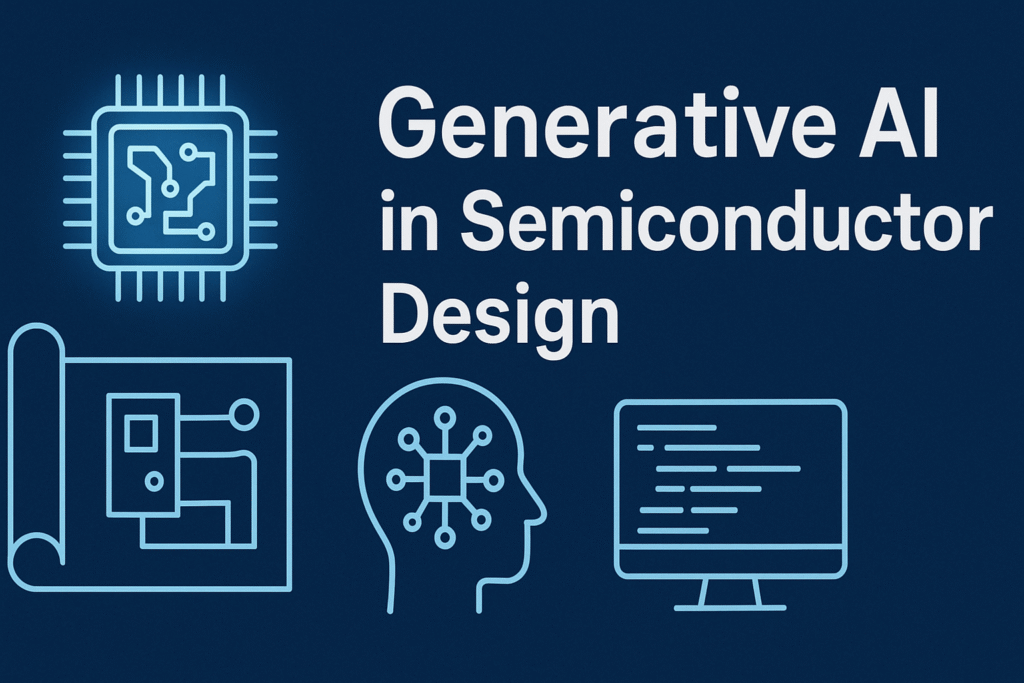Semiconductor design has never been an easy and simple process. Any chip that drives your phone, automobile, or laptop requires months of planning, experimenting, and performance adjustments before it becomes a reality. Now, however, there is a revolution in this whole thing, and it is Generative AI.
The idea of generative AI in semiconductor design is to provide engineers with a smart digital assistant capable of fervent imagination design, and even code writing of new chips. It streamlines the whole process of design blueprints to code, which is faster, smarter, and more efficient. Suppose that chips could be designed nearly by themselves. The world is no longer a dream. It is already happening.
The Challenge of Modern Semiconductor Design
It is very labor-intensive and involves a lot of human skills to develop semiconductors. Some engineers must deal with all the little details, including logic design, power control, coding, and testing. This is not a quick, simple process that is error-free and simple.
The design of the chips is now even more complex with the appearance of modern technologies such as artificial intelligence, the Internet of Things, and enhanced communication methods. The need to have timelines that are longer and faster, and smarter chips has also risen.
Generative AI comes in at this point. It assists engineers to break time constraints, minimize expenses, and enhancing creativity. Rather than eliminating designers, it collaborates with them and makes designing work smarter and quicker.
What is Generative AI in Semiconductor Design?
Generative AI refers to a form of artificial intelligence that develops on existing data and subsequently generates new items. It might be a text, pictures, music, or, in this instance, semiconductor designs.
When used in semiconductor design, Generative AI studies thousands of existing chip layouts, architectures, and performance results. It acquires patterns, what works well, and then it automatically comes up with new design variants.
You can imagine that it is like an assistant who has already learned millions of chip blueprints and can even recommend better ones, depending on what you want to achieve. Similarly to how ChatGPT can write articles or write code, Generative AI in semiconductor design is capable of writing new architecture or even writing working code.
From Architecture Blueprints to Code: How Generative AI Works
The technology of producing a semiconductor is subjected to numerous stages. In the case of Generative AI, all of these steps become more streamlined and quicker.
Step 1: Architectural Ideation
The AI begins generating some architecture ideas, depending on performance, the power constraints, and the necessary specifications. It examines various possibilities that can exceed the imagination of human beings.
Step 2: Design Space Exploration
It then considers millions of possibilities that are possible designs in order to select the most efficient ones. This step assists engineers in striking the optimum balance of speed, power, and size.
Step 3: Automated Code Generation
After the blueprint is made, Generative AI will automatically generate Register Transfer Level (RTL) code or Verilog code, which will be used to describe how the chip will operate.
Step 4: Validation and Simulation
AI then performs different tests to determine potential design mistakes or power problems. It is a simulation of the behavior of the chip prior to even the start of its production.
Step 5: Continuous Optimization
After each test, the AI continues its training and development of designs. Every version that it produces makes it even better.
Key Benefits of Using Generative AI in Semiconductor Design
The impact of Generative AI on chip design is truly remarkable. It offers several powerful benefits, such as:
- Speed and Efficiency: AI reduces design time drastically. What earlier took months can now be done in weeks, saving both time and effort.
- More Innovation: AI can think in new ways and explore unique design patterns that humans may never imagine. This leads to breakthrough chip designs.
- Fewer Errors: With AI-driven validation and testing, the chances of coding mistakes are greatly reduced. It ensures higher accuracy and reliability.
- Lower Costs: By automating repetitive work, AI helps companies save both time and money. Less manual effort means reduced design costs.
- Better Scalability: AI allows designers to create multiple versions of chips for various industries such as automotive, healthcare, and consumer electronics.
Big players like NVIDIA, Synopsys, and Cadence are already using Generative AI tools to speed up their semiconductor design process.
Real World Use Cases of Generative AI in Semiconductor Design
Here are a few ways Generative AI is being used in real semiconductor projects today:
- AI-Driven Layout Generation: Tools can automatically create layouts that are optimized for performance and power consumption.
- EDA Automation: AI is now part of Electronic Design Automation (EDA) tools to speed up design and verification processes.
- Performance Prediction: AI models can predict how much power a chip will use, how much heat it will produce, and how fast it will work, even before manufacturing.
- Hardware and Software Co-Design: AI helps design chips and software together to ensure both function perfectly with each other.
Companies like Samsung and Google are already experimenting with AI-generated chip designs that perform just as well as those made by human engineers, but are created in a much shorter time.
Challenges and Limitations
Even though Generative AI in semiconductor design is full of promise, it does face some challenges.
- Data Requirement: AI models need a huge amount of high-quality data to learn properly. Without enough data, their output is limited.
- Lack of Clarity: Sometimes it is difficult for engineers to understand how the AI reached a particular decision.
- Integration Difficulties: Mixing AI tools with existing design systems can be a bit tricky in the beginning.
- Ownership Concerns: There are still questions about who owns a design created by AI, the developer or the company using it.
The Future: AI First Chip Design
The next big step in semiconductor design is the idea of fully AI-driven design environments. In the near future, engineers will act more as supervisors who guide AI systems rather than doing every task by hand.
We will see self-improving chips, automatically created microarchitectures, and AI-generated code that keeps refining itself. Generative AI will not only make chip design faster but also more creative and sustainable.
From blueprints to code, Generative AI is redefining what is possible in semiconductor technology.
Conclusion
The world of chip design is entering a new age of intelligence. Generative AI is transforming how semiconductors are imagined, designed, and produced. It combines human creativity with machine power to deliver faster, smarter, and more efficient results.
As we move ahead, machines will begin to design the machines of the future. Generative AI in semiconductor design is not just a technological advancement. It is the foundation of the next era of innovation.
The line between imagination and automation is disappearing, and what once felt impossible is now being created chip by chip.













